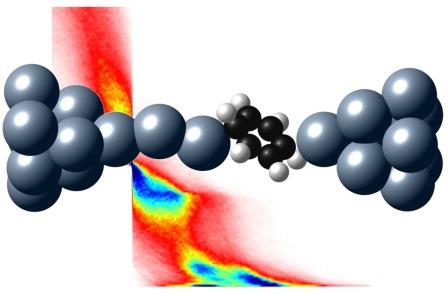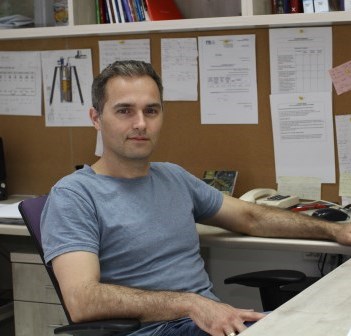Are you a journalist? Please sign up here for our press releases
Subscribe to our monthly newsletter:

The never-ending trend of miniaturization in electronics hits the wall when things get down to the nanometer scale. At this point, it is not enough to make the same device but smaller; new technology is needed. That is why scientists investigate the use of single molecules for electronics. They already know how to get such molecules to conduct electricity, and even how to manipulate the structure of these molecules so as to control the electric current moving through them (in much the same way as a drug molecule’s structure will determine its actions in the body). For example, molecules have been designed to act as switches or one-way valves that regulate the direction of flow of current.
However, to use these molecules in electronic circuits, they must be able to connect with metal wires. Until now, such molecules have been held in place between electric wires before use, but even the smallest wires are several orders of magnitude larger than the molecules. Dr. Oren Tal and research students Tamar Yelin, Ran Vardimon and Natalia Kuritz of the Chemical Physics Department recently took a significant step toward bringing the wires into line with the molecules. They managed to connect a single organic molecule to the thinnest electric wire possible: a single-file string of platinum atoms.

The scientists first trapped a single molecule between two much thicker platinum wires, and then, immediately afterward, they moved the wires away from each other until the platinum atoms in them were pulled into a chain of atoms that was connected to the molecule on one end and a standard metal wire on the other.
The research showed that the electrical conductance of the organic molecule-platinum wire setup was not significantly suppressed by elongating the chains with additional atoms. This implies that such systems might be useful for transferring electronic signals over distances without a significant reduction in intensity. The scientists also experimented with different molecules and molecular structures; they found that different molecules can be wired up in this way. Thus the method could potentially have a wide variety of applications.
Also participating in this research – and helping the group decipher the properties of the new system and the chemical nature of the connection between the atomic strings and the molecule – were the research groups of Prof. Leeor Kronik of the Weizmann Institute’s Materials and Interfaces Department and Prof. Ferdinand Evers of the Karlsruhe Technical Institute in Germany.
Tal’s group and others have already begun to investigate the behavior of electric current when it passes through single molecules connected to the ultra-thin platinum wires. Among other things, the contact points between two very different nanostructures – organic molecules and strings of metallic atoms – may provide new and unique ways of controlling electric current on the sub-nanometer scale.
Prof. Leeor Kronik's research is supported by the Wolfson Family Charitable Trust; the Carolito Stiftung; the European Research Council; the Leona M. and Harry B. Helmsley Charitable Trust; Antonio and Noga Villalon, Winnetka, IL; and the Philip M. Klutznick Fund for Research.
Dr. Oren Tal's research is supported by the Carolito Stiftung. Dr. Tal is the incumbent of the Alvin and Gertrude Levine Career Development Chair.